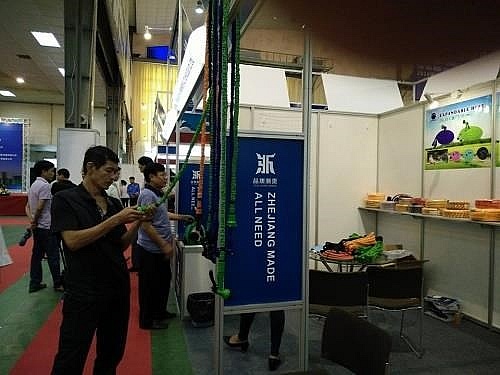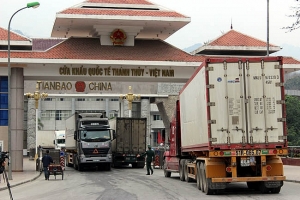Trade impediments continue to stifle Chinese trade
In the first quarter of 2023, Vietnam’s exports are estimated to hit $79.17 billion, down nearly 12 per cent on-year due to a gloomy outlook for orders. Exports fell in the majority of significant markets, mainly the United States, but the reopening of the Chinese economy and continuing restrictions surrounding it was deemed a big factor in the results.
 |
| Chinese trade fair opens in Hanoi, visitors at the event (Photo: VNA) |
“Thailand, Indonesia, and Malaysia want to export more bird’s nests to China, taking advantage of the fact that Vietnam has not yet been granted permission to import this product into this market,” said Nguyen Manh Thanh, director of Khanh Hoa Salanganes Nest. China is a prospective market for Salanganes’ nest goods, which serve mostly Asians.
Thang said that in the Hong Kong market, Vietnam’s bird’s nests are sold for an average of $6,400 per kilogramme, while Thailand, Indonesia, and Malaysia charge 4-5 times as much. He was unaware of the export amount of ASEAN nations to the Chinese market, but he confirmed that Vietnamese bird’s nests harvested from natural islands and sent to China “had more nutritional content” than those house-farmed in other countries.
According to Thang, procedures are now the largest bottleneck for exporting this product to China. “We are in the process of registering product codes, which will permit formal import into China in accordance with the protocol between our two nations.”
In 2022, the Vietnamese and Chinese governments signed a regulation permitting the importation of dried bird’s nests into China. Before that, Khanh Hoa Salanganes Nest shipped a modest quota to China.
The ASEAN-China trade flow has been restored, increasing competition to expand durian exports to this market. According to Nguyen Dinh Tung, general director of Vina T&T Import Export Trading Service, Vietnam’s Ri6 durian variety faces “serious competition” from Thailand’s Monthong, while Malaysia’s Musaking has also established a place in this consumer market. Vina T&T entered into an agreement this year to export 1,500 containers of durian to China.
China imports more than 800,000 metric tonnes of durian, worth almost $4 billion annually. Thai and Malaysian durian have dominated the Chinese market for many years, but Vietnamese durian is beginning to compete after China issued an import licence beginning in July 2022, with 51 growing area codes and 26 authorised packaging facilities.
According to the Vietnam Fruit and Vegetable Association, related shipments to China climbed by 23 per cent in the first three months of 2023. This market currently accounts for over 60 per cent of Vietnam’s fruit and vegetable export revenue. Its rise is largely attributable to the fact that Vietnam and China already have bilateral agreements.
Last month Nong Duc Lai, commercial counsellor of the Vietnamese Embassy in China, said, “Vietnam’s market share of fruit and vegetable exports to China is still humble, accounting for just 9 per cent of China’s annual fruit and vegetable imports.”
After China reopened its market earlier this year, consumer demand on the Chinese market has been recovering. “Vietnamese goods have the potential to sell to China, but they must compete with partners exporting to the Chinese market and with items created in China,” Lai said.
A number of experts noted that transportation costs and export infrastructure are exerting fresh pressure on sales to the Chinese market in the context of Vietnam’s export slump. Since the Laos-Thailand railway line was inaugurated in February, the price competition has intensified, resulting in a 20 per cent reduction in shipping prices as well as a one-day reduction in the time required to convey products to China.
To Ngoc Son, deputy director of the Africa-West Asia-South Asia Market Trade Office at the Ministry of Industry and Trade, said that China is no longer an “easy-going market” due to stricter rules. China is enhancing its apparatus and policy enforcement by enacting modifications to its food safety laws.
| Chinese Prime Minister Li Qiang has pledged to welcome Vietnamese agricultural goods. In a phone discussion last week, Vietnamese Prime Minister Pham Minh Chinh requested that China continue to improve trade facilitation, extend the import of commodities, and speed up the opening of the market for Vietnamese agricultural products. This was the first phone discussion between the two leaders since Qiang’s March 11 election as China’s prime minister. PM Chinh also proposed that Vietnam and China study strategies for preserving smooth trade, enhance the ability and effectiveness of customs clearance, enhance the connection of highway, railway, shoreline, and air infrastructure, increase Vietnamese goods exported via China’s railways, and create a conducive environment for Vietnam to open more trade promotion offices. PM Qiang is said to have stated that China is willing to open its market to Vietnamese exports, particularly agricultural items, and to work with Vietnam to expedite the completion of long-stalled major projects. He recommended that the two sides strengthen strategic connectedness, develop economic-trade cooperation and investment, maintain supply networks and production chains, encourage people-to-people interactions, and revive tourist collaboration. |
In addition to revamping the administrative apparatus, the Chinese government merged a portion of its quality supervision, inspection, and quarantine activities into its General Administration of Customs.
Lv Xiaoqin, chairwoman of SPSS, a port and logistics services firm located in China’s Sichuan region, told VIR last Monday that it has demand for a variety of items, with agricultural items being the largest.
“We value the Vietnamese marketplace. Therefore, we established an investment climate and infrastructure to facilitate the expansion of bilateral commerce,” explained Xiaoqin. “Several shipping ports have been constructed in Sichuan, Zhengzhou, and Yunnan provinces to facilitate commerce between the two nations.”
According to the General Department of Vietnam Customs, Vietnam’s overall import-export turnover with China increased by 5.5 per cent from 2021 to 2022, reaching $175.6 billion.
 | Vietnam-China trade on path to recovery Since the border gates to China were reopened a month ago, as many as 24,000 containers were traded – suggesting a pace that is somewhat more tepid than in the times before the coronavirus (COVID-19) epidemic. However, trade is picking up and local authorities are working to smooth out administrative and bureaucratic procedures. |
 | Vietnam-China trade conference resumes after three-year hiatus From January 10 to 13, a delegation from the Chinese province of Guangxi visited Vietnam for a range of economic and trade development activities. |
What the stars mean:
★ Poor ★ ★ Promising ★★★ Good ★★★★ Very good ★★★★★ Exceptional
Related Contents
Latest News
More News
- Vietnam’s industrial output hits seven-year high in 2025 (January 06, 2026 | 17:47)
- GELEX’s credit rating outlook upgraded to 'Positive' by VIS Rating (January 06, 2026 | 16:49)
- Finance sector lays firm groundwork for 2026 after major reform (January 06, 2026 | 15:30)
- Vietnam’s seafood exports surpass $11 billion in 2025 (January 06, 2026 | 08:51)
- Vietnam GDP posts second-strongest growth since 2011 (January 06, 2026 | 08:35)
- Double-digit GDP growth within reach with shift to higher-value expansion (January 06, 2026 | 08:33)
- Takeda Vietnam awarded for ongoing support of Vietnam’s sustainability efforts (December 31, 2025 | 21:00)
- Vietnam's retail market tops $269 billion in 2025 amid e-commerce boom (December 31, 2025 | 19:00)
- Stronger legal framework urged as trade fraud surges online (December 31, 2025 | 18:58)
- FPT exports first chip shipment to Japan (December 31, 2025 | 10:47)

 Tag:
Tag:

















 Mobile Version
Mobile Version